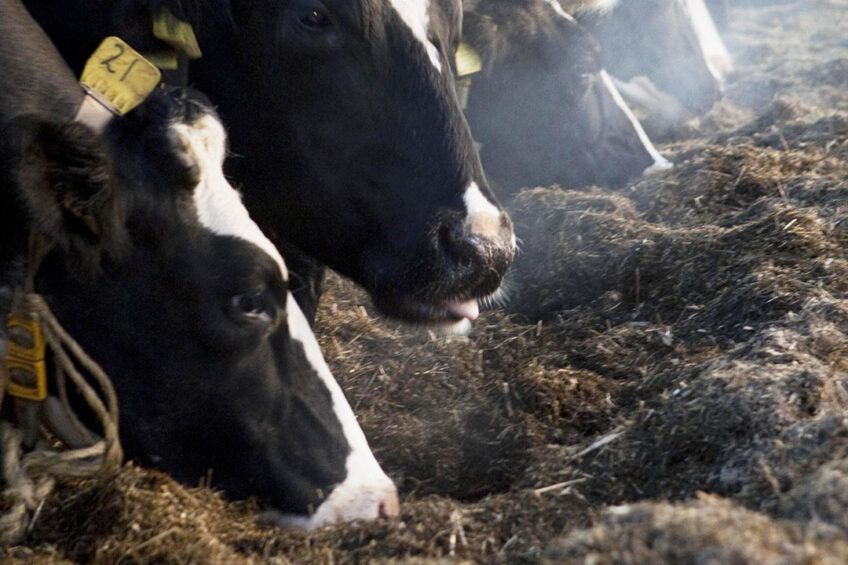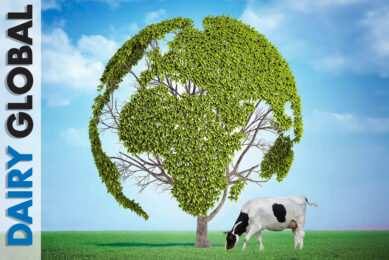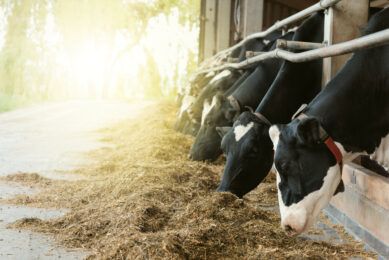Factors affecting fibre utilisation in ruminant feeds

Ruminant animals can digest fibre via microbial fermentation to obtain useful energy needed for various biological functions.
In dairy cows, dietary fibre improves milk fat by increasing the amount of rumen acetate which acts as a precursor of milk fat synthesis. In fattening animals, dietary fibre helps control fat deposition in the carcasses and improves the marbling score sought by the consumer. The response of animals to fibre nutrition may, however, vary depending on several factors.
Feed intake
Total tract digestibility of dietary fibre decreased by 8% and 11% when the level of feeding increased by 1.5x and 2x the maintenance level respectively. The decreased fibre digestibility is strongly related to the high rate of passage from the rumen. A high rate of rumen passage decreases the residence time of feed particles in the rumen. Also, increased intake results in increased rumen fill. As a result, concentrations of volatile fatty acids (VFA) increase, with a concurrent decrease in rumen pH. It has been well documented that cellulolytic bacteria are very sensitive to low rumen pH. Although a high level of intake may depress fibre digestion in the rumen by either way, compensation occurs through increases in gross energy intake and hindgut digestion.

Frequency of feeding
When feeding animals 5-6 times per day, there will be a stable pH in the rumen at levels ranging from about 5.5 to 5.8, but when feeding for only 1-2 times per day, the pH value will, in this case, vary from about 5.1 to 7.1 within the same day. With a stable pH value in the rumen, digestibility of dietary fibre will be increased due to the increased microbial activity in the rumen which results from the increased energy level needed for such an activity (the rumen ATP concentration is 2.5 times more under high-frequency feeding compared to the low-frequency feeding).
Grain feeding
In general, with increasing grain in forage-based diets, the digestibility of the latter is reduced by both a specific (drop in pH) and non-specific effect (carbohydrate or starch effect) on the growth of cellulolytic organisms. The depression of fibre digestion is typically not severe until grain exceeds 30% of the diet. Supplementation with limited amounts of grain (<10% of the diet) may stimulate fibre digestion by increasing microbial activity for attachment to fibrous feeds. a low level of grain supplementation has also been shown to increase the protozoal population which in turn decreases amylolytic and increases fibrolytic activities of bacteria. with low-quality forages, significant production responses can be achieved when forages and grains are well balanced, both at the level of the rumen and the animal.>
During long periods of phosphorus deficiency, this mineral may become deficient in the rumen and will reduce microbial growth efficiency and at times digestibility and intake of forage.”
Dietary protein
Supplementation with protein meals increases voluntary intake of poor quality forages by cattle. This is due to the improved P:E ratio in nutrients absorbed by cattle which reduces metabolic heat production with a subsequent reduction in body temperature and improved forage intake. The protein source is also a factor to be considered. In a study with growing cattle fed high-fibre diets, the growth rate was 642 g/d when fishmeal was used as a protein source and was reduced to only 492 g/d with soybean meal. The difference here was attributed to the fact that with fishmeal there is a slow release of ammonia, increased amount of protein escaping rumen degradation, and increased ratio of specific amino acids escaping rumen breakdown.
Mineral supplement
During long periods of phosphorus deficiency, this mineral may become deficient in the rumen and will reduce microbial growth efficiency and at times digestibility and intake of forage. This problem is often widespread in tropical countries and phosphorus supplementation for the animal and the microbes is, therefore, essential.
Magnesium is also essential for all rumen micro-organisms and particularly for cellulolytic microbes, and supplementation of this mineral is a precondition for the optimal utilisation of low-quality forages.
Buffers in cow nutrition: Points to consider
Buffers are compounds that help to counteract an increase in acidity in the rumen. Here we look at dietary buffer supplementation, the points to consider, health and milk production, and we take a look at the impacts on dairy cows. Find out more…
Use of buffers
The existence of any of the following conditions may reduce rumen pH and reduce fibre digestion:
- Fermentable carbohydrates are included in the diet;
- Particle size is reduced by grinding or other means;
- The natural buffering capacity of the diet is low;
- Feed intake is high; and/or
- Feeding patterns are irregular or concentrated in 1 or 2 short periods per day
The situation may, however, be improved by the addition of buffers. It was found that cellulose digestibility was increased by 5.9% with the addition of sodium bicarbonate and 11.4% with the addition of sodium phosphate over the control diet.
Physical treatment
Chopping and grinding are 2 general methods used to change the ease of ingestion. By these methods, the intact roughage structures are broken down to small particle sizes exposing new surfaces as points of microbial colonisation and thus increasing surface area for enzyme penetration. They may, however, have some negative effects on the degradability of fibre if the straw is ground so fine (1 mm) that rumen retention time is greatly reduced. Ground forages often may further be processed by pelleting or cubing before being fed. The advantage of this treatment is that it further increases bulk density, decreases dustiness, and increases ease of handling.
Fighting mastitis with feed strategies
Mastitis continues to be a problem for dairy producers, afflicting 15–20% of cows worldwide. We look at controlling mastitis through feed strategies. Check it out…
Chemical treatment
Chemical treatments appear to be most beneficial for treating mature lignified substrates. They increase digestibility and intake by increasing solubility of some of the cell wall components or disruption of complexes of lignin and cell wall carbohydrates. Various peroxides and chlorine-containing compounds have been used for this purpose with improved digestibility and increased performance of the animal. Other chemicals such as Ca(OH)2 and KOH have been researched as possible chemical treatment agents. However, Ca(OH)2 is less effective in improving digestibility while KOH is too expensive to be economically feasible, even though both chemicals are attractive as treatments as they would provide Ca and K for the animal.
Biological treatment
Many of the white-rot fungi (WRF) are known to metabolise lignin, cellulose, and other fibrous components in wood species. This capability is derived from the presence of several enzymes involved in the lignin degradation process. However, results of digestibility of treated materials are variable from little to no effects to significant improvement in vitro andin vivo digestibility. Likewise, reports in performance studies are also variable, from unacceptability of treated materials by the animal to no difference between treated and untreated materials in intake by the animal. The use of WRF to treat fibrous feeds should, therefore, require refinement of techniques before it can be widely and practically applied.
References are available from the author upon request.
Join 13,000+ subscribers
Subscribe to our newsletter to stay updated about all the need-to-know content in the dairy sector, two times a week.










